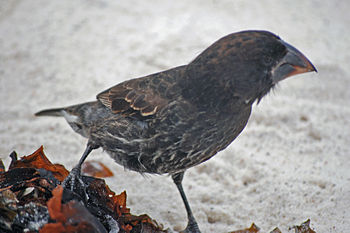 |
| Galapagos Cactus Finch / A Darwin Finch (also known as the Galápagos Finches or as Geospizinae) are a group of 15 species of Passerine birds, now placed in the tanager family rather than the true finch family. (Photo credit: Wikipedia) |
On the Galapagos Islands, you will find thirteen different species of finch. There is some controversy here, as some people report the species count to be fourteen. Each of these species is a direct descendant of one original species of finch that was found on the island. The Galapagos Islands have such varying climates, and temperatures that the little birds had to adapt to the area they lived in whether it be hot or humid.
The biggest adaptation they made was in their beaks. Of the thirteen species of finches found on the islands, you will find different beak structures among them. As years went by, the little bird's beaks evolved to better enable them to eat the food sources most readily available in their habitat. As hard as we work to provide our pet birds with the perfect habitat, and climates, it should amaze us that these little creatures have survived at all. Darwin himself found these little birds to be fantastic adapters to their environment.
All the ground finches, (Small Ground Finch, Medium Ground Finch, Large Ground Finch and Sharp Beaked Ground Finch) have crushing beaks. The Vegetarian Finch also has a crushing beak. While the Tree Finch and the Cactus Finch both have beaks built more for grasping. The Woodpecker Finch and the Warbler Finch, both have beaks suited to probing for their food.
The different species of ground finches use their crushing beaks to pick ticks from tortoises and iguanas for food. They will also kick eggs into rocks and eat the contents of the egg. The Woodpecker Finch will use twigs and cactus spines like tools to dig the larva out of tree branches, one of the only species to use tools.
The Sharp Beaked Ground Finch is often referred to as a vampire. It will land on the backs of the Masked Boobies and peck them to feed on their blood. Rather a vicious little finch.
The thirteen species of finch found on the islands are not considered the brightest or the most colorful of the finch family. In fact, these finches are mostly in shades of grey, black, brown and olive-green.
These amazing little birds manage to survive some extreme and harsh conditions on the islands. Some years there is adequate rainfall and when this occurs there is more than enough food to sustain all the birds on the islands. However, this is not the case every year. Some years the islands are drought stricken and the food is scarce. This is the reason the birds have evolved and adapted to allow them to eat a greater variety of foods. They do not always have the abundance of grass seeds, and their adaptive beaks come in handy.
These compact birds blend into their surroundings very well. They are small like sparrows. The Vegetarian Finch is about the biggest finch on the islands. Their drab colors and quiet mannerisms help to hide them from natural predators.
This is a good thing. The finches from Galapagos are a real treat to see because they are endangered. There are very few of Darwin's Finches left on the islands. Evolution, I guess, can only protect them for so long.
Learn the joy of Finch companionship and how to buy, keep and raise healthy Finches. Come find all the information you need at Galapagos Finches.
By Ralph Siskin
I am Ralph Siskin and I have been raising and learning about Finches for quite some time. I love these birds and want to share what I know with other Finch lovers or people just interested in birds. I invite you to come see my site and read my free mini-course on " Top 10 Secrets To Healthy & Happy Finches" by clicking to http://www.FinchesBirdAnswers.com
Article Source: EzineArticles
|

No comments:
Post a Comment